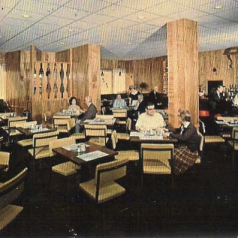
A Blend of Historic Charm and Modern Convenience
At nearly 100 Years Old, The Gould Hotel possesses a vivid history. Construction of the original hotel began in 1919 and the structure would be named The Gould Hotel after its main financier, Gould Manufacturing Company, although there has been a hotel or a tavern at the corner of State and Falls streets since the arrival of the earliest settlers along the Seneca River.
The Gould Hotel opened in February 1920 on the site of the Hoag House which had burned on Thanksgiving morning, 1918. That fire had been discovered in the basement and by noon the building had been a total loss and nearly all of the equipment in the hotel had been destroyed.
This new Gould Hotel was described in the Syracuse Journal as “the most complete and perfectly equipped of the smaller hotels of New York State. Four stories in height, absolutely fireproof in construction and equipped in perfect taste and convenience, it is scheduled to become the mecca for travelers and autoists between Rochester and Syracuse.”
The Goulds Manufacturing Company furnished the capital with which to erect this new building. Not surprisingly, at the first meeting of the men backing the project, it was decided to change the hotel’s name from the Hoag House to the Gould Hotel.
The plans were drawn up by George B. Post and Son of New York City, and provided for a building of four floors, with a main entrance on State Street. Stores would be located on the Fall Street side of the building. Actual construction work was done by the Amsterdam Building Company, starting in the winter of 1919. The new hotel building was of concrete and steel construction throughout. The door and window sills and the picture moldings were the only things of the building itself that could burn. In addition to the large lobby, the double dining rooms and a well-arrange kitchen, the hotel itself had 72 rooms and 8 apartments. Fifty of the rooms were equipped with baths, including hot and cold water, and telephone connections. L.J. Stauf, who had operated the Hoag House, was given a contract to manage the Gould Hotel for 10 years. In an experiment that other hotels might adopt if proved successful, Stauf would operate a laundry which, besides doing primarily the hotel’s laundry, would do commercial work. Mr. Stauf would also operate a candy store, catering to the hotel trade and the Seneca Falls community. H.E. Moyers operated the barber shop. The Auto Club, which had had offices in the Hoag House, opened an office in the new Gould Hotel building.
A feature of this hotel, which no other small hotel establishment in all of New York State had, was a ground level promenade. It consisted of a walled-in court at the rear of the building, with landscaping in the form of a formal garden. This promenade had direct access to the dining and dancing rooms and could be used for summer parties.
The dining rooms were so arranged that they could be one big room for banquets or separate so that one could be used as a ball room and the other for dining. The dining room décor was colonial in style, with the walls painted café au lait and ivory white ceilings and Windsor mahogany chairs and tables.
There was also a third room with a seating capacity of 30 people. This private dining room could be set up as one long table or a group of small tables. This room had a dark green rug and pearl gray walls and velour drapes. Both the woodwork and the furniture were Jacobean in style.
The lobby had a Spanish style appearance, with the furniture covered with heavy Moroccan leather. Heavy rugs covered the lobby floor, with table and floor lamps adding a quiet but luxurious feeling. The walls were finished in imitation Caen Stone and velour drapes.
There were reading and writing rooms which opened off the lobby. These rooms were equipped with wickerware and the walls were hung with tapestries. Eight desks were provided for the use of hotel guests.
The guest rooms had a mahogany dresser, desk, straight and rocker chairs, and portable and fixed lamps. The Simmons’ bed had fine hair mattresses.
The hotel promoters were especially proud of their kitchens. They were equipped by the Brumball Dean Company of New York City. There were three large gas ranges, with broilers, roasters and grills along one side of the room. Steam tables were arranged so that the foods can be prepared and kept hot and still be ready for instant service. On the other side of the room a large battery of coffee urns. There were large ice boxes where entire halves of beef could be kept in such a way that kitchen help could do their carving without bringing the meat into the kitchen proper. The Jewell Refrigeration Company provided these large ice boxes. The Hoag House had enjoyed a reputation throughout the state of fine cuisine and Mr. Stauf promised to maintain that reputation. The hotel is immediately adjoining two of the larger garages of the town, namely the Boyce Garage and the W.D. Kellogg service station. This became important for the Gould Hotel, as an increasing number of guests each year were to come by their own cars.
Because of the fireproof construction, Mr. W.E. Dickey, the sale manager for the Goulds Manufacturing Company and who had leased the main apartment on the second floor, now felt safe to hang his collection of valuable paintings (valued at about $30,000) on the walls of his apartment. Fortunately, he had not felt the Hoag House was safe from fire, so these valuable paintings had not been lost in the fire which destroyed the Hoag House in 1918.
